Immune Response is a mechanism of how the immune system of the host’s body responds to a harmful foreign particle or pathogen (antigen) in the body.
It entails recognizing the antigen and eliciting mechanisms to defend itself from foreign pathogens. Immune responses are induced as a means of protection from antigens which antigens are substances that are found on the surface of cells or viruses or bacteria or fungi. Antigens are normally proteins in nature, however, substances such as drugs, chemicals, toxins, and foreign particles like splinters. Examples of pathogens that induce an immune response include bacteria, viruses, fungi, and parasites. Therefore, the immune system plays a key role in recognizing and destroying or trying to destroy the substances that contain the antigens.
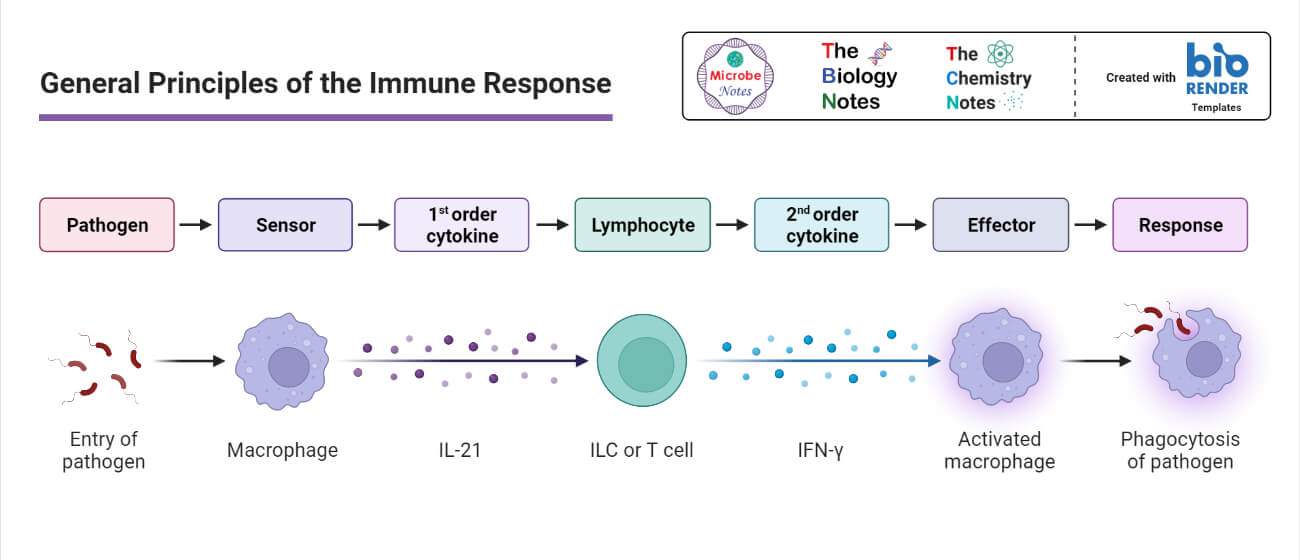
There are two types of the immune response:
- Primary Immune Response
- Secondary Immune Response
Interesting Science Videos
Primary Immune Response
- A primary Immune Response occurs when the body’s immune response encounters an antigen for the first time.
- During this immune response, the body learns to recognize the antigen, produce antibodies against the antigen, and induce a long-term memory response against the antigen.
- Memory induction is enabled by the production of immune memory lymphocytes.
- The response induced involved the activation of naive B-cells and naive T-cells.
- The response lasts about 14 days to resolve.
There are four phases of immune response that take place when the body responds to an antigen for the first time. This is because, when the immune system encounters an antigen for the first time, the primary response elicited is brief and weak and it occurs in these phases i.e Lag, Exponential, Plateau, and decline phase.
Lag phase
- It is also known as the latent phase
- It is the phase of the initial exposure to the antigen.
- This leads to the activation of naive B-cells that produce antibodies to counter the antigen.
- This phase takes a week, activating the specialized B and T cells that come into contact with the antigen.
Exponential Phase
- This is the phase of a rapid increase in antibody production by the differentiated plasma cells (plasma cells)
- The increase in antibody production is because of the large number of plasma cells.
Plateau Phase
- This is a steady phase where the antibody level remains constant to maintain the levels of antibody replenishing and production. This means that the antibodies that get used up equal the antibodies that are produced.
Decline phase
- This phase involves a decrease in antibody levels due to the decline in plasma cell numbers which are dying out of exhaustion of antibody production.
- During this phase, there are no new plasma cells being produced because the antigen or immunogen has been eliminated from the system.
Based on the immune cells activated during an immune response, the primary Immune Responses can also be classified into:
- Primary B-cell Response
- Primary T-cell Response
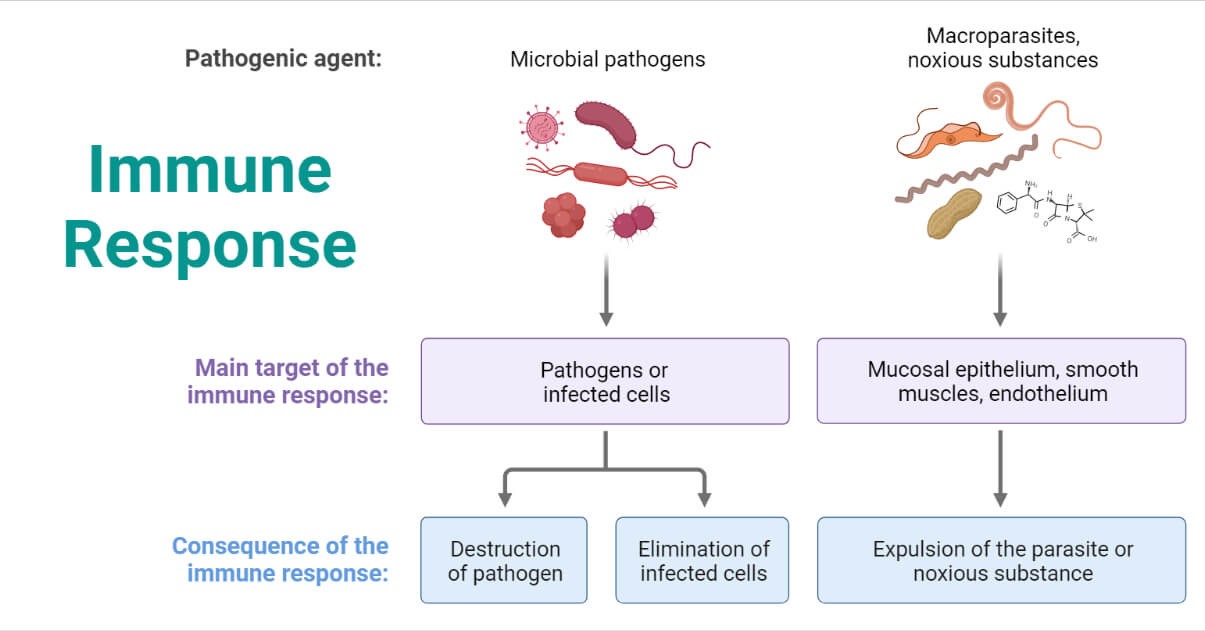
Secondary Immune Response
- This is the subsequent immune response after the primary immune response, also known as anamnestic immune response.
- The response that occurs the second or third or fourth etc time the body encounters the same antigen it encountered during the primary response.
- This response is mediated by the memory lymphocytes that were produced during the primary response.
- Immediately after the same antigen is encountered the memory lymphocytes induce the production of antibodies.
- This response has a very short sharp lag phase which means that both lag and exponential phases take place at ago. The antibody production levels increase rapidly within a short period, normally within a few days.
- This is because of the antigen-specific memory T and B-cells produced during the primary response.
- Because of the rapidity of the secondary response, the antigen gets eliminated as soon as it encounters the memory cells and before it can cause disease.
- The antibodies produced during this response remain circulating freely to ensure complete elimination of the antigen.
Thymus-Dependent and Thymus-Independent Antigens Vs Immune Responses
- It is significant to note that, both primary and secondary immune responses involve active antibody production on an encounter with an antigen however the antibody production is lower in the primary immune responses.
- Therefore, the activity of antibody production is induced by antigens of two types: thymus-dependent (TD) or thymus-independent (TI).
- Thymus-dependent antigens are normally proteins and they associate closely with the B and T lymphocytes after stimulation.
- On activation of the B-cells by the protein thymus-dependent antigens, they are assisted by the T-cells (T-helper cells). This allows the B-cells to differentiate into antibody-secreting plasma cells or memory cells.
- Continued exposure to the antigen generates an increased affinity of antibodies and their subclasses.
- While the Thymus-independent antigens are of two types:
- Type 1 antigens include cell wall components such as lipopolysaccharide, that activate B cells through the Toll-like receptors (TLRs).
- Type 2 antigens such as polymeric proteins and capsular polysaccharides activate the B-cells via the B-cell receptors (BCR).
- Thymus-independent antigens have a unique feature of the presence of repetitive molecular structures also known as epitopes which directly trigger B cells. And therefore, these antigens do not need the help of T-cells.
- Additionally, the TI antigens do not generate an immunological memory nor do they induce a change in antibody affinity or class.
Factors that Influence the Type of Immune responses
- Type of antigen- Primary immune responses are activated by interaction with any type of antigen unlike the secondary immune response that is produced due to an interaction with a protein antigen
- Route of antigen entry- The initial response to an antigen is influenced by the route of entry and entry of an antigen that occurs in either of the three routes. i.e entry through the bloodstream which generates an immune response in the spleen, or entry through the skin and the subcutaneous tissue, which elicits an immune response in the regional nodes of the lymphoid system. Thirdly, antigens may gain entry into the body via the mucosal surfaces such as the gastrointestinal, lung, or reproductive tract which invokes an immune response in the submucosal lymphoid tissues.
- Antigen-presenting cells- The processing of antigens is done by antigen-presenting cells which include dendritic cells, macrophages, and B-lymphocytes with the dendritic cells being the most effective. These cells play a major role in interacting with the antigen, Dendritic cells are predominant in presenting processed antigens to T-cells in primary immune responses. The B-cells function effectively as antigen-presenting cells in secondary immune responses. Antigen-processing and presentation are facilitated phagocytic mechanisms presenting an antigen that has been broken down into peptides in association with the Major Histocompatibility Complex (MHC).
- Antigen Receptors- Antigen interactions with immune cells including the B and T-cells are by the ability of these cells to recognize them (antigens). B-cells possess the B-cell Receptors (BCR) also known as immunoglobulins, to which the antigen bind while the T-cells must recognize antigens that have been processed and bound to the MHC complex molecules to bind to the T-cell Receptors (TCR).
- Antigen Complexity- Antigens have various shapes and sizes and the antigen determinants are also known as epitopes. These epitopes must be recognized by T and B-cells and they must be able to induce an immune response for them to activate B-cells which in turn pass through the Thymus and activate the T-cells. However, some antigens are not immunogenic and therefore they need a carrier protein such as an immunoglobulin for them to be immunogenic thus inducing an immune response against them.
- Other factors that influence the type of immune response include clonal expansion, affinity maturation, class switching, and memory cells.
Examples of Immune Response (Figures)
Immune Response in Type I Diabetes
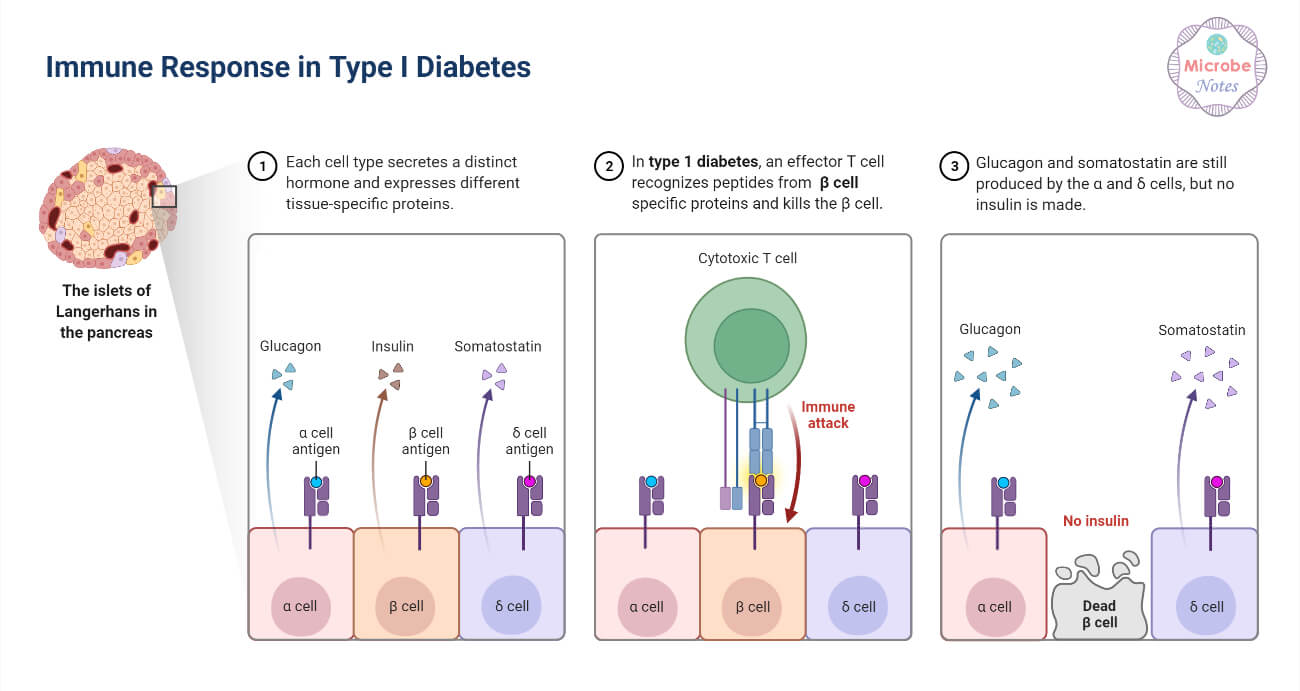
Acute Immune Responses to Coronaviruses
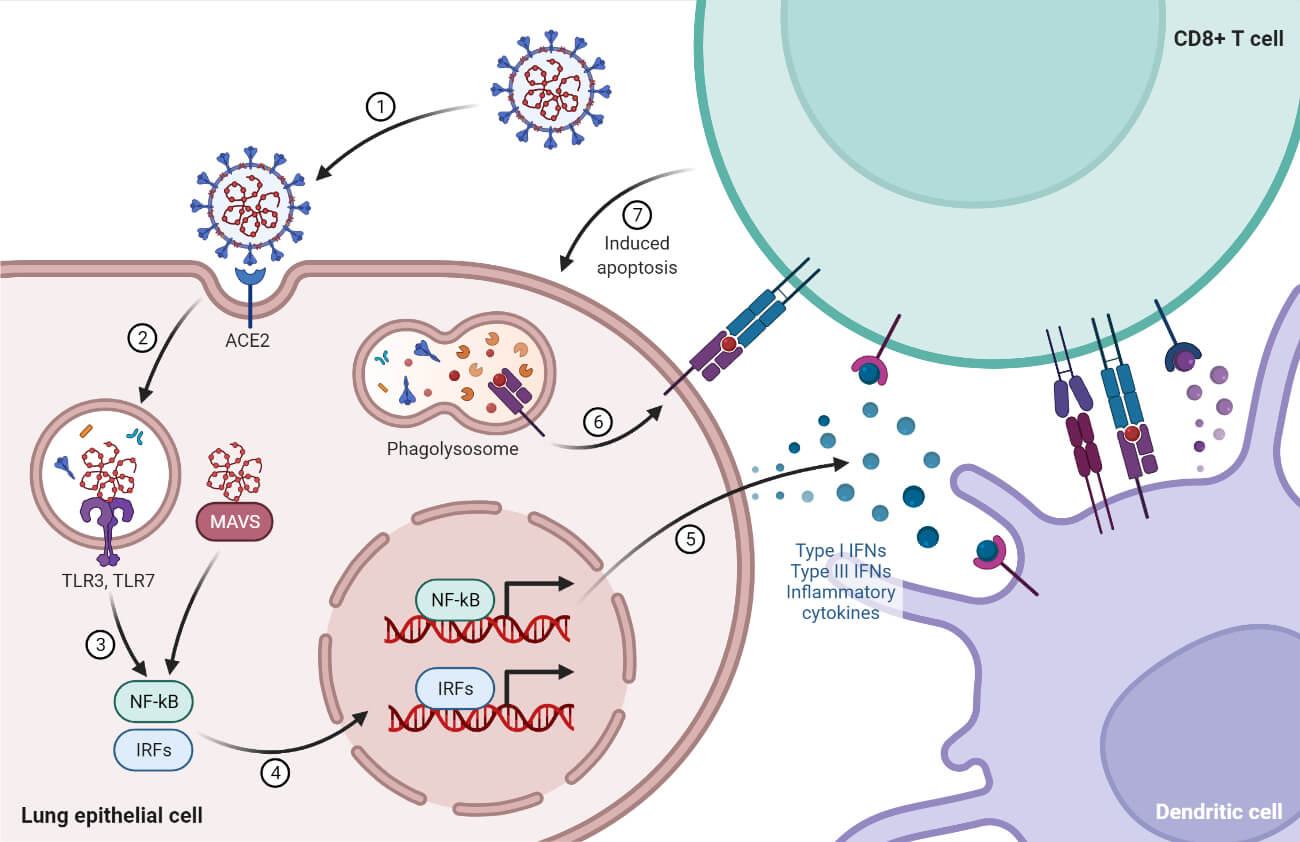
Immune Response in IBD
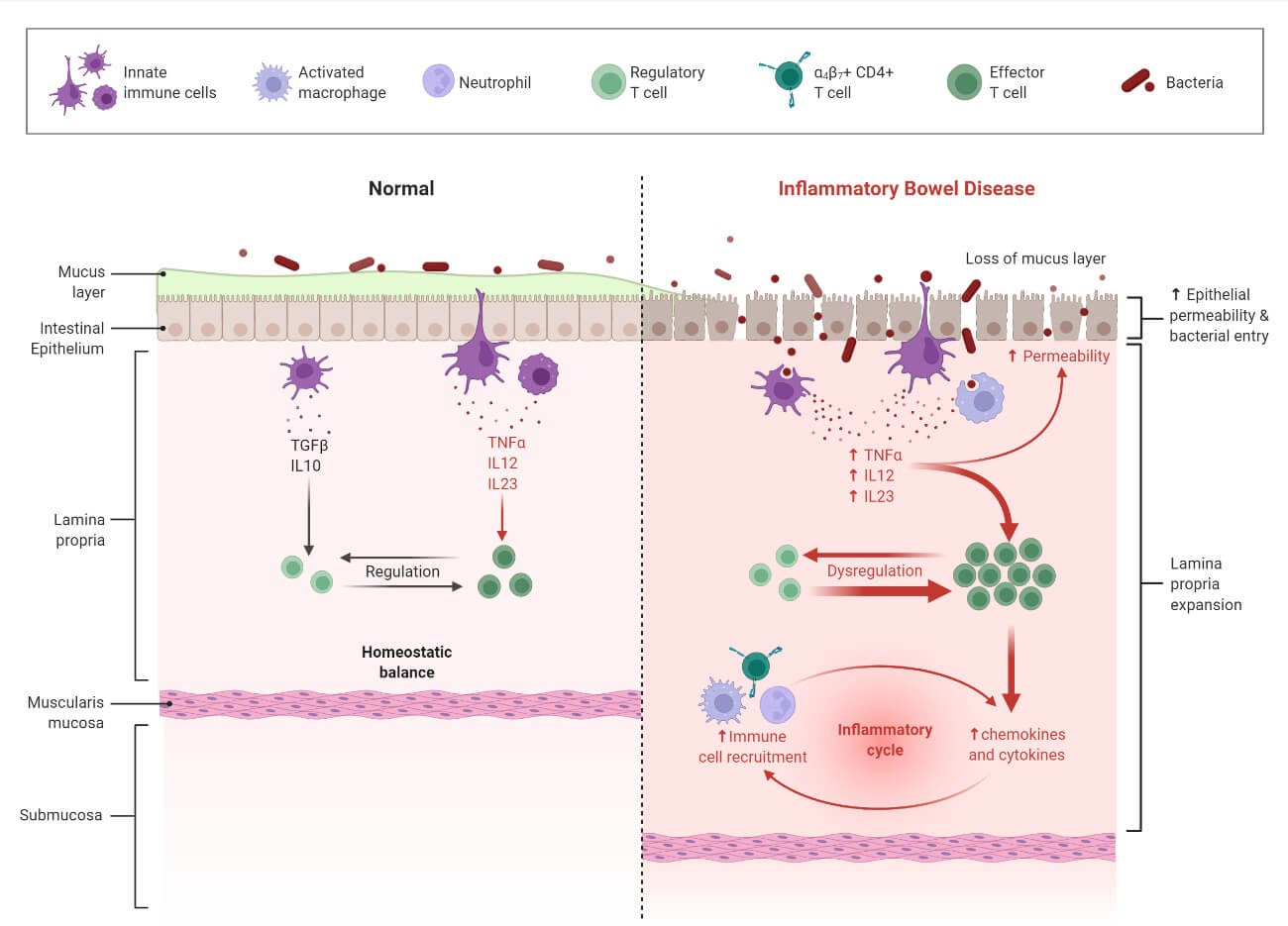
Immune Response to Commensal vs. Pathogenic Bacteria
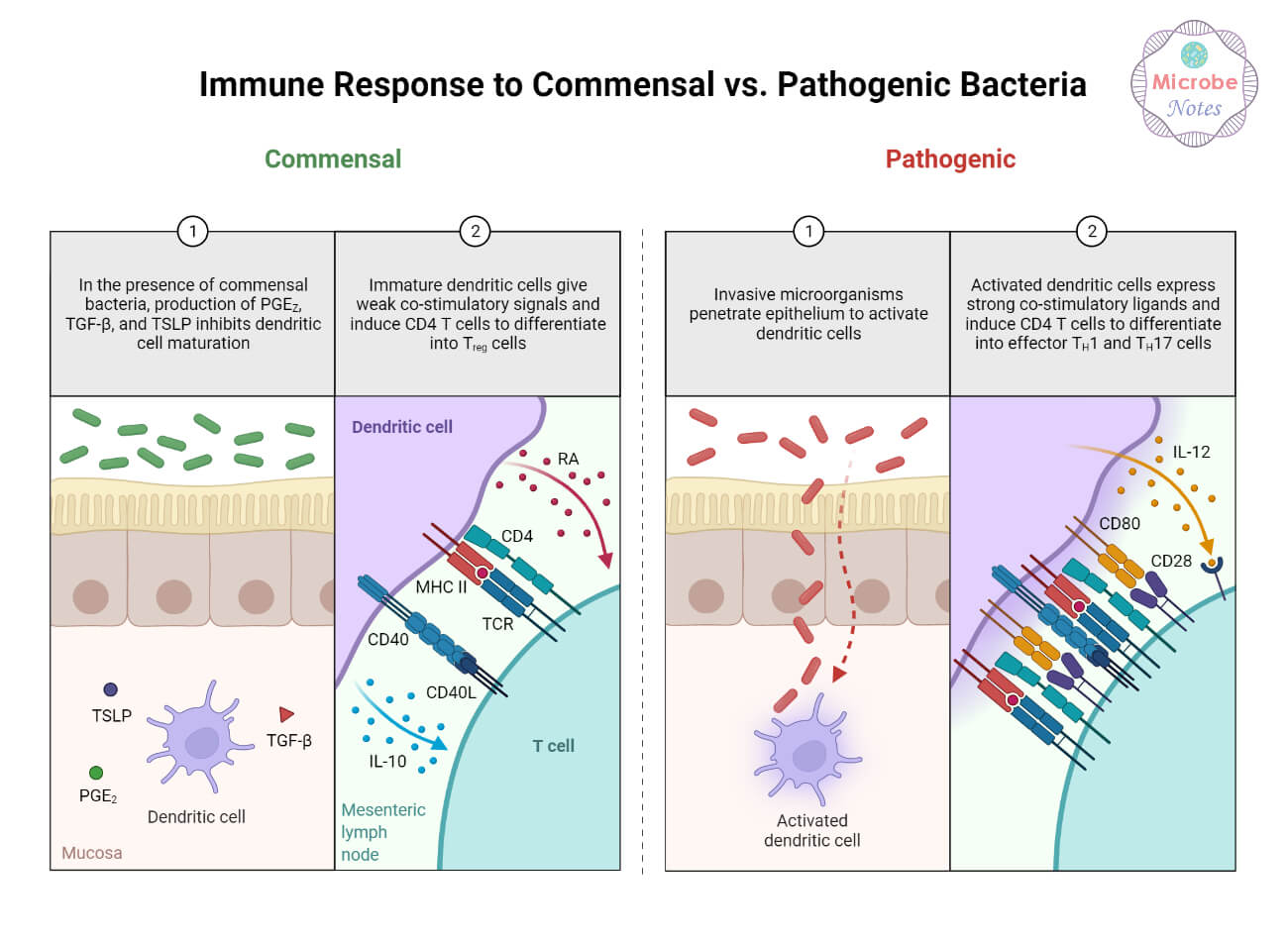
Microbiome and the Anti-tumor Immune Response

Primary Immune Response vs Secondary Immune response
- The primary antibody response that is elicited by the initial encounter with the thymus-dependent antigens does not manifest normally by itself in form of a circulating antibody for a few days. This form of delay is known as the latent or lag phase. It depends on several factors including the nature of the antigen, the route of immunization, dosage, and the species being immunized.
- The initial antibodies are detected in low-affinities of IgM and in high-affinity IgG are detected, especially when the antigen is persistent. Without a continued antigenic challenge, the antibody levels decline subsequently.
- A second exposure (re-exposure) to the thymus-dependent (TD) antigen triggered a rapid secondary antibody response. This leads to the direct generation of the memory cells from the initial primary response.
- The secondary response is normally quicker, with a greater magnitude and sustainable response than the primary response.
- The antibodies that are predominant in the secondary response are IgG or IgA depending on the site of antigen response and of greater affinity than those produced in the primary immune response. This is because the antigen strongly binds to the antibody.
- Secondary response provides stronger better immune protection. Additionally, a secondary T-cell response occurs as a result of re-exposure to antigens, and therefore it elicits a 10,000-fold increase in the respective T-cell specific cytotoxic T-cells.
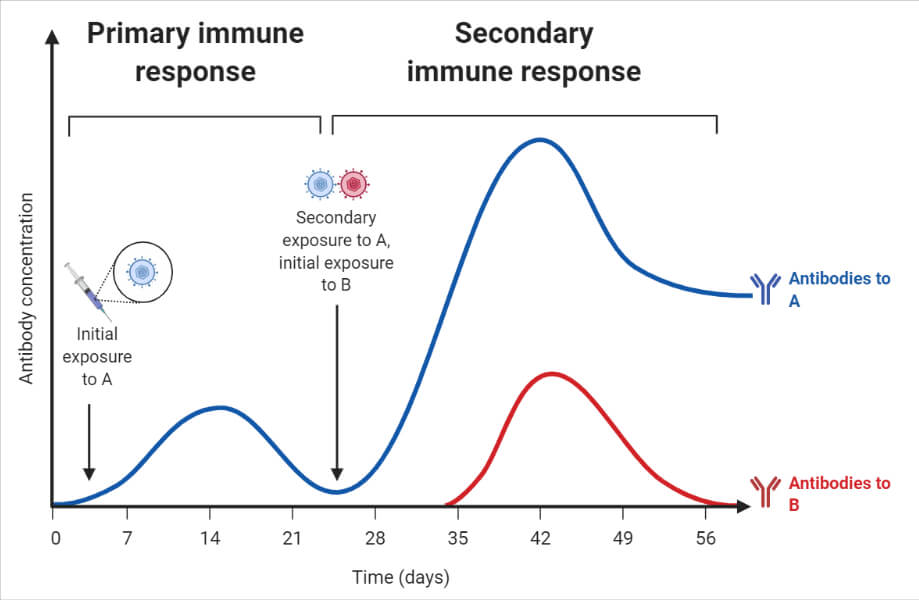
| Characteristic | Primary Immune Response | Secondary Immune Response |
| Causes | It occurs as a result of primary contact with an antigen. | It occurs as a result of a second and subsequent exposure to the same antigen. |
| Cell responses | Responding cells are naïve B-cell and T-cell. | The responding cells are memory cells. |
| Duration of the Lag Phase | The lag phase is often longer taking about 4-7 days or weeks to months even. | The lag phase is shorter taking about 1-4 days because of the presence of the memory cells. |
| Antibody duration peaks (Lag or latent Phase) | The antibody levels peak within 7 to 10 days. | The antibody levels peak in 3 to 5 days. |
| Duration of immune production | The establishment of immunity takes a longer time. | Immunity is established within a shorter time. |
| Antibody isotype production | The first antibody produced is IgM and small amounts of IgG are also produced. | Mainly IgG antibody is produced with a small amount of IgM. Other immunoglobulins such as IgA and in the case of allergy IgE are produced. |
| Antibody frequency | Antibody production depends on the nature of the antigen and usually, the antibodies are produced in low amounts. | Usually, 100-1000 times more antibodies are produced. |
| Antibody levels | Antibody level declines rapidly. | Antibody levels remain high for a longer period. |
| Antibody Affinity | The antibody affinity to the antigen is lower. | Antibodies have a greater affinity for the antigen. |
| Response location | The primary response appears mainly in the lymph nodes and spleen. | The secondary response appears mainly in the bone marrow, followed by the spleen and lymph nodes. |
| Thymus effects | Both Thymus-dependent and Thymus-independent antigen gives the primary immune response. | Only thymus-dependent antigen gives the secondary immune response. |
References and Sources
- Reichardt P, Dornbach B, and GunzerM(2010) APC, T cells, and the immune synapse. Current Topics in Microbiology and Immunology 340: 229–249.
- Ademokun, A.A. and Dunn-Walters, D. (2010). Immune Responses: Primary and Secondary. In eLS, (Ed.). https://doi.org/10.1002/9780470015902.a0000947.pub2
- MURRAY, I. Induction of the Primary Immune Response. Nature 217, 430–432 (1968). https://doi.org/10.1038/217430a0
- https://microbiologynotes.com/differences-between-primary-and-secondary-immune-response/- 7%
- https://www.newhealthadvisor.org/Primary-Immune-Response.html- 4%
- https://science.sciencemag.org/content/293/5528/251.full- 1%
- https://www.differencebetween.com/wp-content/uploads/2017/07/Difference-Between-Primary-and-Secondary-Immune-Response.pdf- 1%
- https://www.merckmanuals.com/home/immune-disorders/biology-of-the-immune-system/acquired-immunity- 1%
- https://www.merckmanuals.com/home/immune-disorders/biology-of-the-immune-system/overview-of-the-immune-system- 1%
- https://www.coursehero.com/file/81202410/PRIMARY-AND-SECONDARY-RESPONSEpptx/- 1%
- https://www.sciencedirect.com/science/article/pii/S1937644819300681- <1%
- http://files.differencebetween.com/wp-content/uploads/2017/10/Difference-Between-T-Cell-Dependent-and-Independent-Antigen-1.pdf- <1%
- https://www.ncbi.nlm.nih.gov/pmc/articles/PMC7826135/- <1%

It was very easy to understand. Thank you for sharing this .